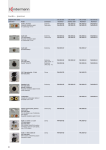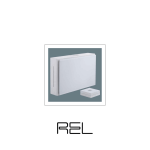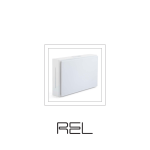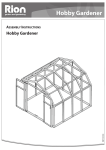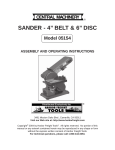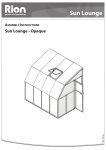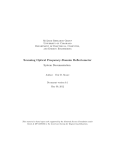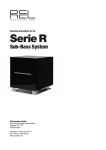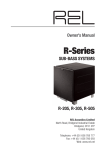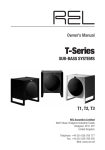Download T ZERO Manual - REL Acoustics
Transcript
O Operating Instructions for the TZERO Sub-Bass System Important Safeguards 1 2 3 4 5 6 7 8 Read all of these instructions. Save these instructions for future use. Heed all warnings. Follow all instructions. Unplug from the wall socket before cleaning. Clean only with a dry cloth. Keep away from water or other liquids. Do not rest drinks, vases or other liquid-filled items on the unit. Do not place on a stand or table; it may fall causing injury to a child or adult and damage to the unit. Do not install near any heat sources such as radiators, heat registers, stoves or other apparatus (including amplifiers) that produce heat. 9 The unit should only be operated from the power source indicated on the panel of the amplifier. 10 Do not defeat the safety purpose of the grounding-type plug. A grounding type plug has two blades and a third grounding prong. The third prong is provided for your safety. If the provided plug does not fit into your outlet, consult and electrician for replacement of the obsolete outlet. 11 Only use the power cord supplied. 12 Do not allow anything to rest on the power cord. Position the power cord such that it cannot be walked on. 13 For added protection during a lightning storm, or when not in use for long periods of time, unplug it from the wall socket. 14 Do not attempt to service the unit yourself, as removing the amplifier may expose you to dangerous voltages. Refer all servicing to your dealer. 15 Unplug the unit from the wall socket and refer servicing to your dealer under the following conditions: a When the power cord or plug is damaged. b If liquid has been spilled onto the unit. c If the unit does not operate properly by following the operating instructions. d If the unit has been dropped and damaged. e When the unit exhibits a drastic change in performance. 1 Warning This item is heavy. To avoid risk of injury, take care when handling. Design Safety This apparatus is supplied with a detachable mains cord. A 2A fuse is fitted in the socket. Should the fuse need to be replaced use a similar rated fuse approved to ASTA or BSI 362 standards. Do not use without the fuse cover in place. Replacement fuse covers are available from your distributor. Important Information The lightning flash with arrowhead symbol within an equilateral triangle is intended to alert the user to the presence of un-insulated dangerous voltage within the product’s enclosure that may be of sufficient magnitude to constitute a risk of electric shock to persons. The exclamation point within an equilateral triangle is intended to alert the user to the presence of important operating and maintenance (servicing) instructions in the literature accompanying the appliance. 2 Welcome to the REL Family Thank you for purchasing a REL TZERO Sub-Bass System. The TZERO is the result of a state-of-the-art collaboration between our American design and engineering team and our British production team. TZERO is conceived as the most cost effective high end product we know how to build. We have spared none of the materials and finishing techniques our larger designs are noted for. Many competing products are clearly the result of cost engineering, however, TZERO is a pure high end product in design and execution. If, like many, you are surprised and delighted by the quality and “suddenness” of bass as rendered by TZERO, know that this is the result of a careful, painstaking iterative process of the sort that so rarely makes it into production at anything like these prices. Many of the sonic virtues – speed, warmth and slam – embodied in TZERO are the direct result of mechanical and acoustic advancements. In particular, we have utilized thick slabs of dense, acousticallyinert MDF, masterfully bonded to create an exceptionally rigid, near-monocoque cabinet. Additionally, the aluminum feet are milled from solid billet and weigh an incredible amount. We thoroughly tested and were able to clearly discern the benefit of having a solid, high mass exit path for deleterious vibration; vibration that would otherwise slow and blur the clarity of bass lines. Make a structure inert and quieter and more of the music emerges. A brief word about the styling, fit, and finish. Each TZERO receives nine coats of lacquer, all of which require hand sanding. The final coat is then turned by hand on a large, industrial rouging wheel using jewelry buffing compound. Finally, the deep, wet gloss is achieved by hand polishing using micro fiber cloth and expensive automotive waxes. All exposed bolts used to attach the rear panel to the TZERO cabinet are polished T-304 stainless steel allen head designs. This extra cost is undergone to ensure that even in humid markets RELs will not oxidize or degrade in appearance. Each badge is milled from solid billet aluminum and is a full 2.5mm thick even though we choose to only reveal 1mm above the surface of the cabinet. Much like the underlying quality of all RELs, more lies beneath the surface than is evident to the eye. 3 Overview TZERO Sub-Bass System Many or most loudspeakers emphasize the mid-bass. This is the range from 50 to 90 Hz. We at REL believe this is an incomplete approach and that loudspeakers need to be extended in the lower frequencies for true full range reproduction. All of our designs are true Sub-Bass Systems, meaning they are designed to reproduce very low frequencies (below 30 Hz) that are felt rather than heard. This is because we understand that music is full-range, as are sound effects on movies, and we intend for our products to reproduce all of these sounds, not just a narrow band. TZERO is equipped to allow you to take full advantage of Dolby Digital AC3, DTS, MPEG 2 and any other digital sound format that includes a dedicated Low Frequency Effects (LFE) channel. The dedicated LFE input meets the tough specification laid down for digital 3/2.1 channels, usually known as 5.1. The output is nominally flat from 35 Hz – 90 Hz. It has a dedicated input level control which enables users to set the LFE level independently of the processor. This is important because not all processors offer control over this significant parameter. The LFE channel is frequently output at 10 dB higher levels than the other channels. The TZERO also has a high-level (speaker level) input with dedicated input level control. Uniquely, both the speaker level and the LFE input can be used simultaneously. This means you may set it up for the best possible 2-channel performance sound with your CDs or other stereo signals and instantly revert to using the Sub-Bass System as the dedicated LFE component when watching movies. This is a feature of real benefit if you wish to play music in stereo mode in the purist audiophile way and also in REL Theater Reference mode with no switching necessary. By connecting BOTH High Level and .1 concurrently and setting your processor to “Large” or “Full Range”, the best possible performance will be obtained. Consult the owner’s manual of your loudspeakers or consult with your dealer before setting to large as a few speakers cannot handle the bass that is then directed through to the main speakers. 4 REL TZERO Rear Panel Connection Legend 1 2 3 1 2 3 8 7 9 10 8 9 4 5 7 6 5 1 Volume Control for HI/LOW INPUT: Use to adjust output when using either HIGH-LEVEL or LOW-LEVEL input. Do not use both simultaneously. 2 Volume Control for .1/LFE INPUT: Use to adjust output level when using .1/LFE input from a 5.1 amplifier or processor. 3 Crossover Control: Used to select crossover frequency. Variable between 30Hz and 120Hz. 4 LOW-LEVEL INPUT: Used to connect LOW-LEVEL to the output of a preamplifier, integrated amplifier or receiver ONLY when HIGH-LEVEL INPUT cannot be properly connected. (For home cinema, use.1/LFE INPUT). 5 .1/LFE INPUT: Used to connect to the .1/LFE output from a 5.1 amplifier of processor. Should be used in conjunction with REL HIGH-LEVEL connection for the ultimate theater experience. 6 Phase Switch: Used to set phase 0-180 degrees. 7 Power Mode Switch: Used to set power mode. Set to “ENERGY SAVER” to enable automatic standby function or to “ALWAYS ON” to disable standby function. 8 HIGH-LEVEL INPUT (Neutrik® Speakon® Socket): Use to connect HIGH-LEVEL to the main front amplifier speaker terminals. 9 Power ON/OFF Switch: Use to turn unit on or off. 10 IEC Mains Socket: Fused mains (AC) input socket that accepts a detachable power cord. 6 Connecting Up Always switch your system off before disconnecting any wires. ALWAYS connect using the REL HIGH-LEVEL input, unless your system simply cannot accommodate this. While rare, a few esoteric systems, such as those that deliver a pure digital signal to active speakers, preclude this possibility. To increase the versatility of connecting up, the TZERO has three separate inputs: A Neutrik Speakon socket and two phono sockets. This is to facilitate use with both two-channel stereo systems and AV surround sound systems. The HIGH-LEVEL, unbalanced, dual-channel (stereo) input is via a Neutrik Speakon connector which is connected to the power amplifier’s left and right channel speaker terminals. This has the advantage of ensuring that the REL receives exactly the same signal as the main speakers. This means that the character of the bass from the main system is carried forward into the sub-bass. This is a very important point and together with the REL’s Active Bass Controller (ABC) ensures far superior system integration of the sub-bass with the main system. The LOW-LEVEL input is via a phono jack that connects to either the .1/LFE output of a home cinema amplifier/processor or to the output of a stereo preamplifier. HIGH-LEVEL and .1/LFE inputs can be used simultaneously. The benefits are two-fold when used with a home cinema system. The .1 Input reproduces the .1/LFE channel and the HIGH-LEVEL connection underpins the main front speakers. The main front speakers should be set to the “large” option on the processor. See “Home Cinema Applications” for more information. Connecting to the Power Amplifier Using the Speakon HIGH-LEVEL INPUT To engage the Neutrik Speakon plug, insert fully into socket and rotate clockwise until locked. To remove the Neutrik Speakon plug, grip body of plug, place thumb on chrome lever, move lever backwards, rotate plug anticlockwise quarter turn and withdraw. The HIGH-LEVEL input is designed to accept the stereo (two-channel) signals from the speaker terminals of your receiver, integrated amplifier or basic amplifier. This has the advantage of ensuring that your subwoofer receives exactly the same signal as the main speakers, which means that the character of the bass from the 7 main system is carried forward into the Sub-Bass System. This is a very important point and together with REL’s Natural RollOff™ circuitry, ensures far superior system integration of the Sub-Bass System with the main system. HIGH-LEVEL INPUT: Connections should be made to the same binding post on main amplifier as the main speakers. Red to amplifier main right speaker red terminal, yellow to amplifier main left speaker red terminal and black to amplifier main speaker black terminal, right or left but not both. Plug the Neutrik Speakon plug into the HIGH-LEVEL Speakon socket. Note: This connection does not draw power from the power amplifier and, yes, your REL is a powered sub bass system. However, by deriving its signal from the main power amplifier, better sound quality is achieved. .1/LFE INPUT: This requires a phono-to-phono cable and is a dedicated true .1 channel. This circuit therefore eliminates the normal Natural RollOff™ Crossover and passes the .1 LOW-LEVEL signal through with only the required 120Hz fourth-order filter. LOW-LEVEL INPUT: This single channel phono input allows for conventional connection to a preamplifier and should be used in the rare event that a HIGH-LEVEL connection proves incompatible. Plug one end of a single phono-phono cable into the LOW-LEVEL input jack of the REL and the other end into either the left or right channel output of your preamplifier. Because much sub-50Hz bass information is mono, there is little need to connect both left and right channels. Should your system require this style of connection – HIGH-LEVEL is preferred – additional performance is available by purchasing a second, matching REL and running each as separate stereo subs. PHASE SWITCH – Used to set phase Position 0 / HIGH-LEVEL, LOW-LEVEL or LFE: 0 degrees phase Position 180 / HIGH-LEVEL, LOW-LEVEL or LFE: 180 degrees phase PHASE SELECTION AFFECTS BOTH HIGH- AND LOW-LEVEL INPUTS Crossover is always engaged for HIGH-LEVEL INPUT. The .1/LFE signal does not pass through the crossover circuit. 8 REL Set-Up Made Simple REL products are not traditional subwoofers, but are true Sub-Bass Systems. A REL is designed to augment the performance of “full range” speaker systems in order to provide, in certain cases, linear response below 12 Hz. Therefore, for the moment, set aside everything you’ve been taught about subwoofers and how they are integrated into a stereo or home cinema system. The set-up and positioning of REL Sub-Bass Systems differs from that of conventional subwoofers. A REL will take advantage of physics and room acoustics to provide deep pressurization as no traditional subwoofer can. It is important that you bring to the set-up process a willingness to do things a little differently in order to obtain these superior results. The end result of your labors will be an utterly seamless integration of true deep bass to a sound system, regardless of the main speakers’ low bass capability. Basic set-up should take no more than ten to fifteen minutes to accomplish once connected. Before You Begin 1 It is helpful to know that you will almost always connect the REL to the input on the rear panel labeled “HIGH-LEVEL INPUT.” This connection is made using the supplied 34’, 10” (10 meters) cable, the bare leads of which connect to the speaker output terminals of the power amplifier. The easy and foolproof connection at the REL is done with a Neutrik Speakon connector. The purpose of connecting to the speaker output terminals is one of the unique secrets of REL’s success. By connecting to the high-level input on the REL from the amplifier, you build forward the sonic signature of your main system, including the tonal balance and timing cues of the entire electronics chain. In this way, the REL is fed the exact signal that is fed to the main speakers. 2 When possible, the REL should be placed in one of the corners behind the speakers. Remember, we are dealing with true LOW bass pressurization with RELs. Low bass pressurization below 40Hz is best derived from corner placement, where the most linear and efficient low bass can be produced. Connecting and Setting Up HIGH-LEVEL connection, using the enclosed cable with the Neutrik Speakon connector, is always the first choice. This connection can be made without affecting the performance of the amplifier because the REL’s amplifier input impedance is 150,000 ohms, in effect not producing any additional demand whatsoever on the rest of your system. 9 • The standard HIGH-LEVEL hook up procedure is: attach the red wire to the amplifier’s right positive speaker output terminal; attach the yellow wire to the amplifier’s left positive speaker output terminal; attach the black wire to whichever of the amplifier’s ground output terminals is convenient; plug the Speakon connector into the Sub-Bass System’s HIGH-LEVEL input. Supplied Neutrik Speakon HIGH-LEVEL Interconnect Yellow Black HIGH-LEVEL Input Red Release Lever + L – + R – Amplifier Main Speaker Outputs • For differential (i.e. fully balanced) amplifiers using one REL, simply use the standard connecting scheme with the exception of connecting the black wire to chassis ground (i.e. a metal bolt or screw, preferably not painted or anodized, on the chassis of the power amp or receiver), not to a negative speaker terminal, and then connecting into the HIGH-LEVEL input on the REL. Please contact your dealer should there be any questions concerning this or any other hookup procedure. Supplied Neutrik Speakon HIGH-LEVEL Interconnect Black Yellow Red Chassis Screw + + L – + R – Amplifier Main Speaker Outputs NOTE: The TZERO is equipped with internal circuitry to allow seamless connection to Class-D (digital) main amplifiers. If connecting to a Class-D amplifier, follow the above connection procedure for differential amplifiers. 10 • If connecting two RELs in a stereo configuration, connect the black wire of each REL to the negative speaker terminal of the corresponding amplifier channel; twist together the red and yellow wires of each REL separately and connect each pair to the positive speaker terminal of the corresponding amplifier channel. Supplied Neutrik Speakon HIGH-LEVEL Interconnect Left Sub Supplied Neutrik Speakon HIGH-LEVEL Interconnect Yellow Red Black Yellow Red + L – Right Sub Black + R – Amplifier Main Speaker Outputs • If connecting a single REL as a dedicated center channel sub, connect the black wire of the REL to the negative center channel speaker terminal; twist together the red and yellow wires and connect this pair to the positive center channel speaker terminal. Supplied Neutrik Speakon HIGH-LEVEL Interconnect Yellow Red Black + C – Amplifier Main Speaker Outputs 11 • If connecting a REL as a dedicated rear channel sub, connect the black wire of the REL to either the left rear or right rear negative speaker terminal; connect the yellow wire to the left rear positive speaker terminal; connect the red wire to the right rear positive speaker terminal. Supplied Neutrik Speakon HIGH-LEVEL Interconnect Yellow Black Red + RL – + RR – Amplifier Main Speaker Outputs LOW-LEVEL connection (via phono connector) is always an option if HIGH-LEVEL connection is not possible. When connecting to the LOW-LEVEL inputs in a system in which HIGH-LEVEL connection is not possible, such as if using internally-amplified speakers, connect a single phono cable between the LOW-LEVEL input jack of the REL and either the left or right channel output of your preamplifier. Because virtually all sub50Hz bass information is mono, there is no need to connect both left and right channels. When connecting to a home cinema system where a .1/LFE channel output is present, connect a single phono cable between the sub output of the processor/receiver and the .1/LFE input jack on the REL. Positioning: The optimal position for a REL is in one of the corners behind the main speakers. This position provides 9 dB of acoustic amplification and allows for the most linear true low bass wave launch, owing to the ability to tune the REL to the longest distance in the room in order to produce the longest, therefore lowest, bass waves. The Process: To begin the set-up process, choose a piece of music that has a repetitive bass line that is very low in frequency. We suggest track four from the soundtrack to Sneakers (Columbia CK 53146). This has a repetitive bass drum throughout that gives you plenty of time to move the woofer around, but more importantly, the venue was quite large for this recording, and therefore it has a very deep and large-scale bass signature. This type of track is perfect for the set-up process and should be played at the highest reasonable level expected for system playback. 12 Working with a partner, one in the listening position and one at the REL manipulating the controls, is the most effective and efficient way to set up the REL. If working alone, the initial steps in the set-up can be very effectively carried out from the location of the REL. Trying to ignore all other music in the track, listen for the bass drum and its effect on the listening room. Phase Orientation: Once in the corner phase can be adjusted. This may be the single most critical step, and because it really is quite simple, it is often over-thought. Keep in mind; the right phase is whichever position is the loudest or fullest. While playing music with true low bass, adjust the crossover to a point where the REL and the speaker are sure to share frequencies (about halfway up, or at 12 o’clock on the crossover control, or slightly higher for smaller speakers). At this point turn the HI/LOW LEVEL control up so that both the REL and speaker are roughly equal in volume and then switch, using the phase switch, from “0” to “180” phase positions. Again, whichever position is loudest or fullest is the correct position. That is, when the position is working in harmony with your main speakers, reinforcing bass, not cancelling it. Placement: The next step is to determine precisely how far from the corner the sub should be placed to achieve the most efficient output, as well as the lowest frequency extension. With the REL fully into the corner, and continuing to play the music, slowly pull the REL from the corner on the diagonal, equidistant from both side and rear wall. At a certain point (sometimes a matter of only a few inches, in rare cases a foot or more) the REL will audibly go lower, play louder, and, if it truly locks on to the room and is fully pressurizing it, the air around the REL will seem to be energized, stop right there! This is the correct position from the corner for the REL. Crossover and Level Settings: To determine the crossover point, take the volume of the REL (using the HI/LOW LEVEL control) all the way down, and put the crossover to 30 Hz. At this point, bring the REL’s volume back up slowly to the point where you have achieved a subtle balance, i.e. the point at which you can hear the REL even with the main speakers playing. Now, bring the crossover point up until it is obviously too high; at this point bring it down to the appropriate lower setting. For all intents and purposes, this is the correct crossover point. Once this stage has been reached, subtle changes to volume and crossover can be made to provide the last bit of complete and seamless integration. With that, set-up is complete. 13 Hint: There may be a tendency to set the crossover point too high and the volume of the Sub-Bass System too low when first learning how to integrate a REL with the system, the fear being one of overwhelming the main speakers with bass. But in doing so, the resulting set-up will be lacking in bass depth and dynamics. The proper crossover point and volume setting will increase overall dynamics, allow for extended bass frequencies, and improve soundstage properties. Note, volume must be adjusted in conjunction with crossover changes. In general, when selecting a lower crossover point, more volume may need to be applied. REL Theater Reference™ Home Cinema Applications For Dolby Digital AC3 or other 5.1 theater systems, once the standard set-up for two-channel outlined above is complete, the LFE output from the processor or receiver should be connected to the .1/LFE input and appropriate volume adjustments made using the .1/LFE LEVEL control. For this configuration, you must set the processor to the “large” or “full range” setting for the left and right speakers in order for the REL to receive the bass signal via the high-level cable. In this configuration, the REL provides support for both the left and right speakers for two-channel listening, and support for the LFE when movies are playing. Most processors will allow you to defeat the subwoofer output when listening in the two-channel mode. The effect of this set-up is one of greatly increased dynamics in the mid-bass range, no bass bloat, and a greater degree of space and timing from the special audio effects. REL Theater Reference 3D Bass™ While slightly more complicated than the basic REL Theater Reference scheme, use of three RELs produces a number of noteworthy benefits and proves the most cost effective method of achieving professional Dolby 5.1 standard bass performance. REL Theater Reference 3D Bass™ produces true full range performance from the three primary zones of reproduction in theater sound resulting in a far more natural and immersive experience than ANY single sub can produce. 1 The main L/R speakers should be connected to the primary REL using REL Theater Reference connection. This unit forms the foundation of your theater system’s performance and so should be perfectly matched to one’s main speakers. 14 2 In the rear corner (ideally that which is opposite the primary sub), connect a second REL to the rear speakers using REL Theater Reference connectivity. The purpose of the rear channel REL is to ensure proper front-to-rear balance and weight; too often virtually ALL the power and weight in a theater comes from the front and it produces unnatural weighting as well as hot spots. By placing a rear REL diagonally opposite, bass transects the room on a tangent and has the effect of greatly smoothing overall in-room response of your RELs. This unit need not be a duplicate of your primary REL; instead it should match well with your surround speakers. 3 Connect to the center channel a third REL using ONLY the HIGH-LEVEL connection. This may be easily accomplished by connecting directly to the connection terminals on the rear of the center channel speaker. To do so, first twist the red and yellow leads together and connect to the positive terminal, then connect the remaining black lead to the negative (black) terminal on the rear of the speaker. The purpose of the third “center” REL is to ensure the center channel can keep up with the scale, weight and dynamics the main system now has. Location should be anywhere from the opposite corner of the front wall to somewhere in the middle of the front wall, listen for best integration with the center channel speaker. Some people prefer to use the REL as an actual pediment or stand for their center channel, the choice is yours. Again, this unit need NOT be an exact duplicate of the primary REL but should be chosen for its acoustic ability to mate seamlessly with your center channel. First, carefully set-up and dial in the primary REL, then move to the rear REL and balance this against the main REL. Care must be taken to ensure phase is identical on both RELs as accidentally reversing phase of one relative to the other will result in a dramatic reduction in bass output. Finally, carefully dial in the performance of the center channel sub. Hint: To make this easier, once the primary REL has been dialed in, unplug it using the Speakon connection from the system and dial in the rear, followed by the center channel REL. Genuine sticklers for perfection find it easiest to tune in sections. For example, connect ONLY the L/R mains and the primary REL. Next, tune ONLY the rear surrounds and the rear REL. Finally, listen to and tune ONLY the center channel with the center REL. 15 When you have accomplished this task, plug all three units in and re-check your gain settings as the cumulative effect of hooking all three up will usually result in, temporarily, excessive output. Work carefully and methodically to reduce the settings on primary, then rear, and finally center channel RELs and in a few minutes balance should be restored. However, the net result of all your tuning will be a sound that utterly immerses the theater owner in a rich natural wash of bass that suffuses the room effortlessly, rather than what is often experienced as too loud a bass balance pushing uncomfortably at the listener. Running In Care taken over running in will be rewarded by many years of pleasurable use. Both the electronics and the drive unit will benefit from an initial period of carefully controlled use. Possible damage may be sustained by running in the unit at too high a volume setting over an extended period. On the other hand, by taking a little care over this initial period, about 24 hours of actual use, a longer life with an eventual higher potential performance is assured. Care and Polishing The cabinets are best maintained by using a light automotive spray-on wax and a micro fiber cloth. (We use a spray-on made by a company called Griot’s Garage™. While this may not be available in all markets, you can use a similar product.) Take care not to spray the aluminum badge. Do not place objects, such as drinks on top of your REL TZERO. Never use a dry cloth on this finish. Technical TZERO uses a very fast, gentle and transparent filter intended to allow excellent impulse response and a natural sound. We refer to this circuit as Natural RollOff™. Most subs use slow, very steep filters that lend an unnatural, machine-like quality to the sound. The TZERO employs a highly refined Class-D amplifier which combines high performance and high efficiency. The TZERO includes an automatic power-saving mode which ensures that, when not in use, the unit consumes as little power as possible. The driver is simple, rugged and relatively light, and yet offers excellent self-damping so we are better able to reproduce the nuance of music and preserve the explosiveness of transients. Finally, the cabinets, apart from being physically beautiful, are like finely tuned instruments that are largely responsible for the sonic virtue with which the TZERO is imbued. 16 Power Saving Efficiency All REL Sub-Bass Systems are designed for maximum power efficiency, both when passing a signal through to its resultant output sound into the room and also when silent. In addition to the low power draw exhibited by all REL models, the TZERO also features an automatic standby mode that is enabled when the power mode switch on the rear of the unit is set to the “ENERGY SAVER” position. In this mode, the input signal is constantly monitored for activity (audio information). If no audio information is detected over a period of fifteen minutes, the unit will enter a low power standby mode in which less than three watts of power is consumed. When input signal activity is detected, the unit resumes normal operation. By using the energy saver mode, you can ensure that there is no unnecessary power draw when the unit is not in use. Alternatively, the user has the option to leave the unit in the normal operating mode at all times by selecting the “ALWAYS ON” position of the power mode switch. In this mode, the unit will not enter standby regardless of whether or not there is activity on the input signal. Using this setting ensures that the TZERO is ready to react instantaneously to bass transients, whether in music or movies, and is therefore the recommended setting to achieve the highest performance 17 Specifications TZERO Type: Drive Unit: Lower Frequency Response: Input Connectors: Input Impedance: Gain Control Range: Power Output: Phase Switch: Amplifier Type: Protection System Fully Electronic SET-SAFE: D.C. Fault: Output Short: Mains Input Voltage: Fuse: Dimensions (WHD): Sealed, down-firing active woofer 6.5in., 165mm long-throw, steel chassis 38 Hz at -6 dB in room High-Level Neutrik Speakon, Low-Level single phono, LFE phono High-Level: 150k, Low Level: 10k, .1/LFE: 10k ohms 80 dB 100 Watts (RMS) Yes, 0 or 180 degrees Class D Yes Yes Yes 100-240 volts 2.00 Amp semi delay 8.5 x 9.5 x 10.25 in., (216 x 241 x 260 mm) Including Feet and Rear Panel Controls 15 lbs. (6.8 kg) Gloss Piano Black or White Lacquer Net Weight: Finish: Supplied Accessories Mains Lead: Yes Neutrik Speakon Interconnect: Yes (10 Meters Nominal) User Manual: Yes In the interest of product improvement, REL Acoustics Limited reserves the right to alter these specifications without notice. 18 Notes 19 REL Acoustics Limited North Road, Bridgend industrial Estate . Bridgend, CF31 3TP . United Kingdom Telephone: +44 (0)1 656 768 777 . Fax: +44 (0) 1 656 766 093 Web: www.rel.net






















